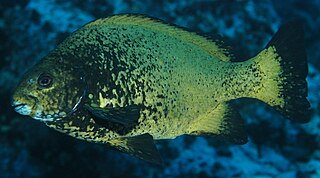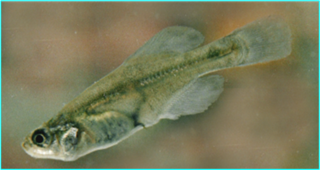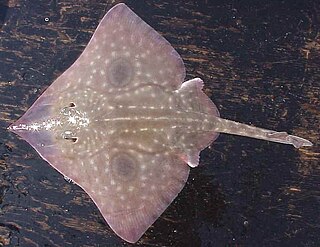
Cobitidae, also known as the true loaches, is a family of Old World freshwater fish. They occur throughout Eurasia and in Morocco, and inhabit riverine ecosystems. Today, most "loaches" are placed in other families. The family includes about 260 described species. New species are being described regularly.

Acantopsis is a genus of freshwater fishes, commonly known as horseface loaches or banana-root fishes, in the family Cobitidae. Fishes of the genus Acantopsis inhabit sandy riverbeds throughout Southeast Asia and are most diverse in the Mekong River in Thailand, Laos, and Cambodia wherein five species are known to occur. The common horseface loach, A. rungthipae, is popular in the aquarium trade.

The sea chubs, also known as rudderfish and pilot fish and in Hawaiian as enenue or nenue, are a family, Kyphosidae, of fishes in the order Perciformes native to the Atlantic, Indian and Pacific Oceans usually close to shore in marine waters.

Freshwater sleepers are a small family, the Odontobutidae, of gobiiform ray-finned fishes native to freshwater rivers flowing into the South China Sea and the northwestern Pacific Ocean. The family consists of about 22 species in six genera.

Crenimugil is a genus of mullets found in coastal marine waters and rivers in the Indo-Pacific region.

Misgurnus is a genus of true loaches found in Europe and Asia. The origin of the name Misgurnus comes from the Greek word miseo and the Turkish gür (loud), a name given to them due to their habit of becoming very active during barometric pressure changes that occur during thunderstorms. The common names, weather loach or weatherfish, also derive from this behavior. Some species of misgurnus are eaten, mostly in Asia, and are also sold as pets in the aquarium trade. Their average size can range from 6 to over 12 inches.

Lepidocephalichthys is a genus of ray-finned fish in the family Cobitidae.
Leptobotia is a genus of fish in the family Botiidae endemic to China.
Protocobitis is a genus of loaches endemic to Guangxi in China and living in caves.

Characodon is a genus of splitfins endemic to north–central Mexico. Two of the species are highly threatened and restricted to pools, ponds and springs in the upper San Pedro Mezquital River basin in Durango. The third species, C. garmani, was restricted to springs near Parras in Coahuila, but it became extinct when they dried out.

The Chapultepec splitfin, known locally as mexcalpique, is a critically endangered species of fish in the family Goodeidae. It is endemic to Mexico and was originally restricted to lakes and wetlands in the Valley of Mexico, including Lake Texcoco. Through man-made channels it was able to spread to the upper Pánuco River basin. Most native populations disappeared as they were at or near Mexico City, with the waters either being reclaimed, drained, heavily polluted or infested with introduced species. Today the Chapultepec splitfin is only known to survive in three lakes in the Chapultepec park of Mexico City, Lake Xochimilco, Lake Zumpango, Laguna de Tecocomulco northeast of the City where perhaps introduced, and parts of the Pánuco River basin. Most of these remaining populations are small. This species was originally described as Cyprinus viviparus in 1837 by Miguel Bustamante y Septién with the type locality given as "Mexico". In 1860 Pieter Bleeker raised the genus Girardinichthys with a new species Girardinichthys viviparus as its type species, this subsequently proved to be a taxonomy of Cyprinus viviparus.

Siniperca or the Chinese perch is a genus of centrarchiform ray-finned fish native to freshwater habitats in continental East Asia. Although its native ranges can extend to northern Vietnam, the majority of the species are entirely or largely restricted to China.
Acanthopsoides is a genus of freshwater ray-finned-fishes belonging to the family Cobitidae, the true or spined loaches. These small fishes are found in Asia.
Koreocobitis is a small genus of loaches endemic to the Korean Peninsula.

Bangana is a genus of fish in the family Cyprinidae, the carps and minnows. It is distributed across much of southern and eastern Asia. Species live mainly in the flowing waters of tropical and subtropical rivers.

Odontobutis is a genus of freshwater sleepers native to East Asia and Vietnam. Species in this genus are generally ambush predators with stout bodies, large heads and a wide, rounded pectoral fins. They can be found in small ponds, lakes and river habitats, often in fresh water of brackish water. This genus evolved during the early Miocene epoch during the Neogene period.
The iridescent toothcarp or pearl-spotted killifish(Paraphanius mento) is a species of killifish in the family Aphaniidae. It can be found in Western Asia. It occurs in a wide range of freshwater habitats. It grows to 5 cm (2.0 in) total length. This species was described in 1843 as Lebias mento by Johann Jakob Heckel with the type locality given as Mosul in Iraq. The acanthocephalan parasite Triaspiron aphanii was found to infest 90% of a sample of Iridescent toothcarp.
Pseudosinocyclocheilus jinxiensis is a species of cavefish in the family Cyprinidae endemic to Xiaolong Spring in Jinxi County, Guangxi, China. In 2016, it was proposed that this species should be placed in its own genus Pseudosinocyclocheilus, a move subsequently supported by Catalog of Fishes and FishBase.

Beringraja is a genus of skates in the family Rajidae with up to six described species. Formerly, they were included in the genus Raja until 2012, when the genus Beringraja was erected for the two species which had multiple embryos per egg capsule. Genetic evidence has led to four additional species being proposed for inclusion in the genus, although this issue has not be completely resolved. These large skates are found in the North Pacific.

Troglonectes is a genus of troglobitic fish in the family Nemacheilidae, native to caves of Asia. Fishbase and other authorities place these species in the genus Oreonectes.













